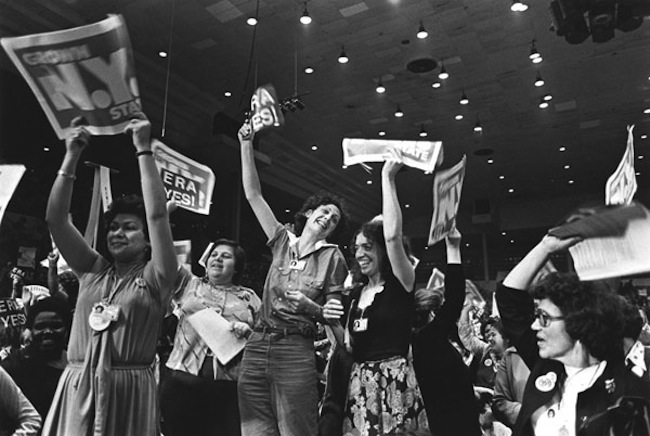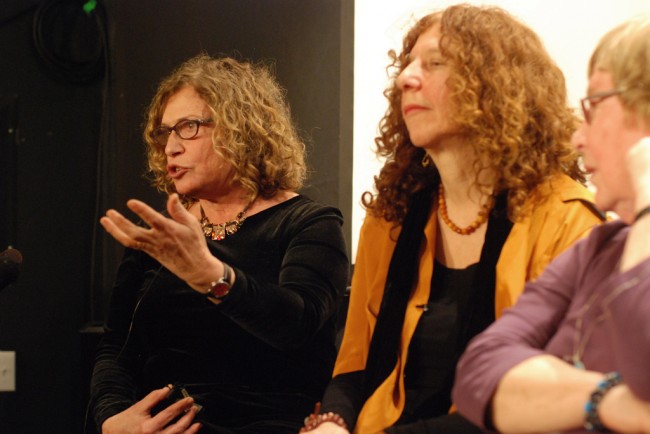
We are celebrating 15 years — and counting — of stories that are deeply researched and deeply felt, that build a historical record of what the city has been.
We are celebrating 15 years — and counting — of stories that are deeply researched and deeply felt, that build a historical record of what the city has been.
A few hours before I went to see Christine Noschese’s 1985 documentary Metropolitan Avenue at local documentary arts center UnionDocs, I biked the Williamsburg stretch of the eponymous street. At its juncture with Kent Avenue along the East River waterfront, I looked through a chain-link fence across a nub of concrete pier out toward Manhattan. Turning up an incline and heading southeast toward the Brooklyn Queens Expressway (BQE), I passed a warehouse-turned-apartment building, an art house theater, and a lumber store (or at least a grating mural depicting one) along one block. Then tenements, bodegas, a tucked away restaurant, and a music club transplanted from Manhattan. The implied heads of a fancy hat store looked across to an empty playground, neighbor to a barren enclosure under the overpass. Further east, toward Queens, the avenue became more residential – with clapboard-sided homes and brick tenements fronted by fire escapes – then widened (after the White Castle) into the domain of factories and warehouses as I approached Newtown Creek.
Anyone familiar with this Metropolitan Avenue of today will recognize many of Metropolitan Avenue’s grainy, opening shots of the north side of Williamsburg and Greenpoint. Yes, glossy blue glass towers on the waterfront have replaced the red and white check of the now-demolished Brooklyn Union gas tanks as the eye-catchers of the skyline, but the Festival of Our Lady of Mount Carmel still brings Italian-American parishioners into the streets every July, and pigeon keepers continue to fly their flocks of pigeons above the roofline. The commonalities between past and present do not end there, but neither do they abound, as goes the narrative of rapid change and shifting character that has come to characterize Williamsburg, now branded as the epitome of gentrifying space.
The film documents the neighborhood in its late-1970s iteration as a working class bastion. Rather than focus on the industry that dominates the historical and architectural memory of the area, Noschese concentrates on the organizing efforts of a subset of working women in its black, Polish, and Italian communities in the face of cuts to public services. The film rests firmly in the 1970s, and does not explicity discuss the neighborhood today, but I found it impossible to view the film through any other lens but that of the present. In her introduction, Noschese framed Metropolitan Avenue similarly, calling it “a film of nostalgia.”
Beyond the two reels of scratchy 16mm print, this longing is not embedded in the film itself, but in Noschese’s depiction of a diverse, family-oriented community, viewers are served ingredients that commingle to form a lingering sense of loss. Kids hang out in the streets, lean up against cars, or are wheeled around in a shopping cart by Yoda on Halloween. Miniature Hulks and Spidermen glam nearby. You do not see these scenes in the Williamsburg of today. A community rally along Metropolitan Avenue now, if it happens at all, is unlikely to include a rendition of “Happy Birthday” in honor of a beloved local fireman.
People’s firehouse demonstration. Photograph via NCNW/NWWGThe palpable sense of community in the film is a testament to the compelling women at the center of the neighborhood. In 1975, Noschese, a Brooklyn native, immersed herself in Williamsburg as an organizer for the National Congress of Neighborhood Women (NCNW), an international activist organization with its roots still firmly planted in the neighborhood. The city’s fiscal crisis was setting in, and Williamsburg and Greenpoint suffered heavily from the divestment that plagued much of the city. The women Noschese profiles in the film fight the removal of public services on many fronts: a police precinct, a firehouse, a daycare center, a senior center, bus service. They make the case for maintaining McCarren Park, touching on a struggle for public space in the neighborhood that runs to the present day. Their stories and memories evoke the Williamsburg of yet another past. As the women sit tight in their lawn chairs in the middle of the street watching the long arm of a machine tear into their homes in the name of business — eminent domain used to make room for an expanding box factory — they recall the home demolitions of the 1950s that made way for the community-splitting BQE.
One strength of the film, though too brief, is Noschese’s demonstration of how these individual women reckon with significant obstacles in their paths. These women — Mildred Johnson, a transplanted black senior living in the Cooper Park public housing development; Sally Martino-Fisher, a middle-aged, lifelong Italian-American resident; and Pat McGinnis, a Polish-American whose parents had settled in the area after immigrating to the states — dealt with a host of entrenched biases not easily overcome. In one of the film’s many striking oral history-style interviews, Sally Martino-Fisher speaks of the fear she initially had at the influx of black residents into the predominately white neighborhood that, according to Ida Susser, an anthropologist, organizer, and adviser in the making of the film, was “deeply racist” at the time. In a conversation that followed the screening, Noschese further recounted squabbles about class identification among the women: the black public housing residents pinned as poor by the “middle class,” private home-owning Italian- and Polish-Americans, while the only significant differences between the groups were race and housing rather than net worth.

Christine Noschese with resident Sally Martino-Fisher and Neighborhood Women Williamsburg Greenpoint. Photograph by Janie Eisenberg via NCNW/NWWG
But the story we see is that of a triumphant community; it largely lacks the background on how this community formed in spite of these internal tensions. For a present-day neighborhood that grapples with a sometimes tense coupling of the black, Polish, and Italian communities represented in the film, an artist population, and a newly settled wealthy class (not to mention the Latino population of the Southside), the community building that preceded the collective action in the film would be a welcome history from which to learn.
The nostalgia for the diverse, working-class, family-centered community that runs through many conversations on the future of Williamsburg and Greenpoint, the same nostalgia the film brings forth, almost assumes that a strong community in the neighborhood is no longer possible. Jan Peterson, the founder and director of NCNW, long-time Williamsburg resident, and Noschese’s entrée into the neighborhood, disagrees with this notion. In her conversation with Noschese and Susser following the screening, Peterson defended the neighborhood’s existing pockets of community while acknowledging their fundamental difference from those presented in the film. As Peterson noted, neighborhoods take on new characteristics and forms over time, and community is not naturally occurring. It is continually constructed over time. Noschese was not so sure about Peterson’s take on the present: When she came back to the neighborhood, contemplating a follow-up film, she was consumed by the lack of community she encountered.

Post-screening discussion with filmmaker Christine Noschese, anthropologist Ida Susser, and National Congress of Neighborhood Women (NCNW) founder and director Jan Peterson. Image via Union Docs
Yes, the community in the film is beautiful…and gone. But this narrative lacks nuance; it fails to acknowledge existing, if haphazard, communities and excludes the potential for fusing these factions going forward. Certainly, the challenges of the neighborhood today are very different from those in the 1970s. Housing is increasingly unaffordable and infrastructure not up to the task of the boom in population growth over the last ten years. The burned-out buildings and wasteland lots that only briefly appear in the film, though prevalent at the time, are now being replaced with overpriced luxury developments often lacking architectural value.
The women at the film’s core, however, demonstrate remarkable understanding, perseverance, and adaptability that allowed their community to grow around them, despite their challenges. The traits of leadership and tenets of community building on display still hold true — mutual aid and support, deconstruction of stereotype through personal connection, and acknowledgement of commonality despite difference and disagreement — as evidenced, for example, in action following disasters like Sandy. Metropolitan Avenue provides a welcome reminder of the potential for disparate groups to embrace these principles and build community as they make a neighborhood their home.
The views expressed here are those of the authors only and do not reflect the position of The Architectural League of New York.